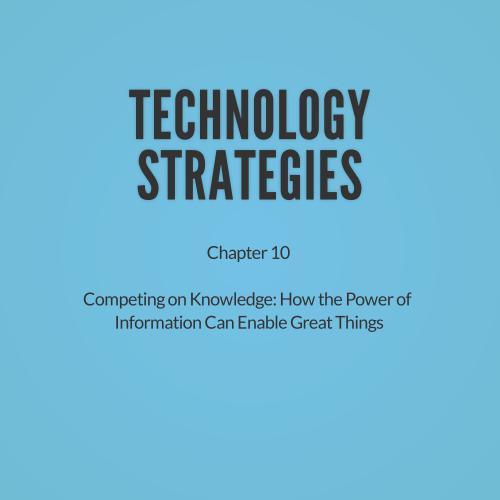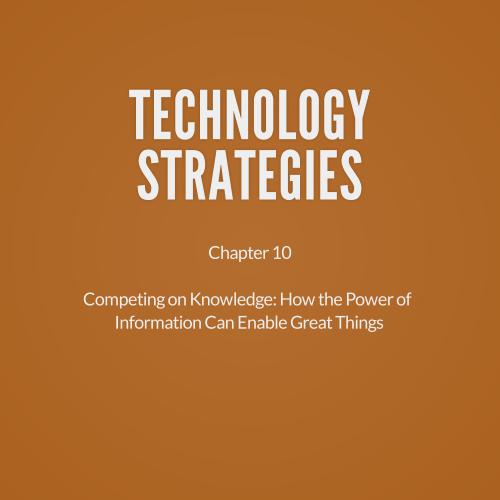TECHNOLOGY STRATEGIES
slides by :
[Group One]
Major Brock
Nicole Stroble
John Hunt
Business Use of Information
- We live in digital age
- Information is the the heart of all commerce
- Knowledge is the basis of all competition
- Information Asymmetry
- Differences in information
- Explains why companies adapt differently
- Pros of Advances in Technology
- Better information
- Timelier Information
- Cons of Advances in Technology
- Overabundance of Information
- Insufficient time to decrypt all of the information
-
Competitive advantage relies on the ability to decipher and act on undiscovered opportunities.
How to Analyze your business
Dr. Kellie Keeling defines business intelligence as
“Technologies and Processes that use data to understand and analyze business performance”
she takes that from Davenports, “Competing on Analytics”
*Davenport, Thomas H. "Competing on Analytics." Harvard Business Review (2006): 1-11. Web. 22 July 2014.
- Considered the organizations Brain
- Informationalize: “Keep and analyze information about everything related to one’s business and use it to inform business decisions.”
- Compatibility is a big factor
- Same Operating systems
- Network infrastructure
The Importance of INFRASTRUCTURE
- Technology infrastructure is everything necessary to support the analyzing and implementing of data for a company.
- Usually behind the scenes, yet an integral part of the company that can quickly lead to downfall.
- It is important for the systems to all be connected so that something that impacts one part of the company will coordinate with other parts of the company.
INFORMATION: A VALUED ASSET
- Information is one of the most important and under-appreciated assets in the hospitality industry.
- When used properly, information can provide a business with a competitive advantage
- Hospitality companies can use information about their guests to provide them with great customer service
DATA VS. INFORMATION
- Data and information is often thought to be the same thing
- Data are "the raw ingredients that comprise information (Nyheim, 175). "
- Information is when "patterns begin to emerge (Nyheim 175)" in data
- Moe Russel says the following when talking about technology used in agriculture:
- "Data is one thing - information is another. Growers need information, not data."
- RUSSELL, M. (2011). DATA VS. INFORMATION. Corn & Soybean Digest , 71 (10), 64.
Data Hierarchy
- Data is like the foundation, everything is built on top off it
- This is why data integrity is important
- "Information is gained from analyzing and interpreting the data and conclusions represent the actions to be taken based on the information. "
-
Rogers, Y., Sharp, H., & Preece, J. (2011). Data Gathering.
Interaction Design
. West Sussex: John Wiley & Sons Ltd.
- Knowledge is built on experience using information
- Wisdom comes with the use of knowledge over time
- Confidence comes as you ascend the data hierarchy
- With intelligence comes confidence and power
- Action comes after building the confidence to act on
Data Hierarchy

- Knowledge is built on experience using information
- Wisdom comes with the use of knowledge over time
- Confidence comes as you ascend the data hierarchy
- With intelligence comes confidence and power
- Action comes after building the confidence to act
Information as a Valued Asset
- Information is one of the most important and under-appreciated assets in the hospitality industry.
- When used properly, information can provide a business with a competitive advantage
- Hospitality companies can use information about their guests to provide them with great customer service
Information Overload
- Technology gives access to so much it causes information overload
- Businesses experience this when they cannot manage the information they are collecting
- "Many organizations are frustrated by the sheer volume of information they receive, but most know that there is value in this information, if only they knew how to extract it (Morrish 46)."
-
Morrish, I. (2013, February 1). How to Manage Information Overload. NZBusiness, 46-47.
- Technology can cause information overload but can also help prevent it through the use of data management systems.
- Data management systems include:
- executive information systems (EIS)
- decision support systems (DSS)
- database management system (DBMS)
- intranets and the corporate data network.
Working Smarter With Information
-
Managing and making decisions should be done by informed business individuals.
-
Unfortunately many do not use up to date technology and still rely on (out of date) analyzing.
- Out of date corporate based analyzing often leads to lagging indicators.
- Better Tools
- DSS - Decision Support System
-
EIS - Executive Information System
At the heart of a DSS is its statistical tools used for modeling, simulation, and predictive analysis (trying to forecast future trends, behavior, and outcomes). Whereas an EIS focuses more on communicating performance results, a DSS’ primary emphasis is on understanding these results over time and what they mean in terms of future -Nyheim p182
They integrate into other systems, such as the DBMS, the website, and other programs that are already using, analyzing, or creating data and information.
Balanced Scorecard
Instead of a single measure or single category of measures, what is proposed is a composite of integrated and telling measures or key indicators, [or]critical success factors, across a variety of categories
The customer's perspective.
Wrapping it Up
Sources/Links
- Nyheim,,P and Connolly, D. (2012). Technology Strategies for the Hospitality Industry. Prentice Hall ,
- Davenport, Thomas H. "Competing on Analytics." Harvard Business Review (2006): 1-11. Web. 22 July 2014.
- "Data Mining: What Is Data Mining?" Data Mining: What Is Data Mining?N.p., n.d. Web. 22 July 2014.
- Russell, M. (2011). Data VS. Information. Corn & Soybean Digest , 71 (10), 64.
- Rogers, Y., Sharp, H., & Preece, J. (2011). Data Gathering. Interaction Design . West Sussex: John Wiley & Sons Ltd.
- Morrish, I. (2013, February 1). How to Manage Information Overload. NZBusiness, 46-47.
- Using a Balanced Scorecard Approach to Measure Performance" opm.gov Office of Personnel Management. Web 23 July 2014
¿ Questions ?
There are many kinds of technologies that assist with managing information overload. The systems mentioned in our textbook were executive information systems (EIS), decision support systems (DSS), database management system (DBMS), intranets, and the corporate data network. Have you ever used one of these or another information management system and how did it improve or decline data management for you?
What is one way companies in the hospitality industry can use information a valuable asset?
What are certain tactics companies could use to improve the way they informationalize their business? Primarily, what are technology factors that could go into this?
In terms of Customer Analytics, what would be the differences of using a program such as Google Analytics, compared to other types of online market research, such as data mining?
Why should businesses pay keep in mind the data hierarchy and data integrity?
In considering the contest between using technological programs , tools and alogorithms and using "people power" with research and intuition - In your opinion is it better to side with technology or with people if there is a tie?
Chapter 10
By itec586
Chapter 10
Chapter 10 Competing on Knowledge: How the Power of Information Can Enable Great Things
- 560



